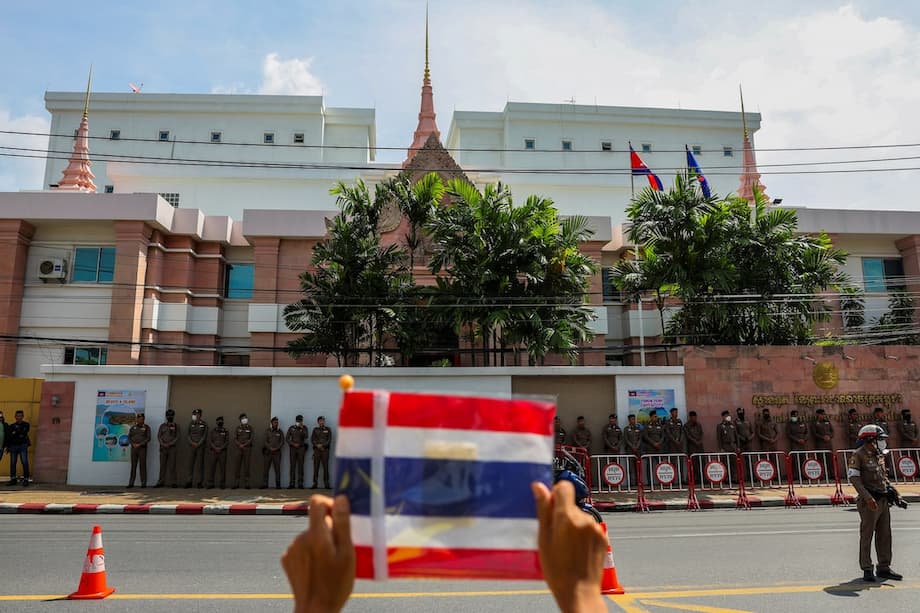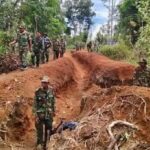A war of narratives as a fragile ceasefire strains
Thailand has escalated its public diplomacy over recent border clashes with Cambodia, accusing Phnom Penh of waging a disinformation campaign that endangers a fragile ceasefire and undermines peace talks. The Thai Ministry of Foreign Affairs said the Cambodian government and state-aligned media are pushing misleading claims to win sympathy at home and abroad, calling the effort propaganda for war. Cambodia has rejected accusations of wrongdoing and insists it is committed to a ceasefire. Both governments continue to trade allegations of violations along an undemarcated frontier that has been contentious for decades.
- A war of narratives as a fragile ceasefire strains
- What Thailand alleges on the ground
- Disinformation and the information battlefield
- Fighting, ceasefire, and realities along the line
- The human toll on both sides of the border
- Diplomacy, law, and a path to de-escalation
- What satellites and fences say about intent
- What could reduce risk now
- Key Points
The latest flare-up followed a lethal skirmish in late May and heavy fighting that erupted on July 24, when Cambodian rockets struck targets in Thailand and Thai air strikes hit back, according to several outlets. A truce mediated on July 28 by Malaysia, with participation from China and the United States, halted the most intense fighting. The ceasefire remains fragile, with troops standing close to one another in hotspots and both sides accusing the other of new breaches. Civilians have paid a steep price, with reports ranging from at least 24 civilian deaths during the five days of fighting to a broader toll of at least 43 people killed and hundreds of thousands displaced in total.
Diplomatic efforts have continued even as tensions linger on the ground. Delegations met in Kuala Lumpur to reinforce the truce and discuss border management, while ASEAN observers and international partners monitored developments. Yet claims and counterclaims over landmines, drones, and cross-border provocations have fueled a harsh information battle that complicates any path to sustained calm.
Thai spokesman sets out the case
Nikorndej Balankura, director general of the Department of Information and spokesperson for Thailand’s Ministry of Foreign Affairs, publicly challenged Cambodia’s narrative. He argued that while Phnom Penh pledges to honor a ceasefire, its actions on the ground do not match those statements. He also referenced a report by Jane’s Defence Weekly that Thailand says shows satellite imagery of a Cambodian military base built months before the clashes, which Bangkok portrays as evidence of intent to escalate. Cambodia has not accepted those allegations.
Speaking in a formal statement, Nikorndej said Cambodia’s behavior amounts to “propaganda for war,” adding that it risks inciting violence and obstructs efforts to find a peaceful solution.
What Thailand alleges on the ground
Thailand has listed four main actions it says violate the ceasefire and inflame tensions. Officials accuse Cambodian forces of laying new anti-personnel landmines along sections of the frontier, deploying drones to harass Thai troops, encouraging Cambodian civilians to stage protests near the border, and placing powerful improvised explosive devices inside Thai territory. Thailand’s claims have not been independently verified in full, and Cambodian authorities deny planting new mines or seeking to provoke confrontations. Independent media and humanitarian access to the most sensitive areas remains limited.
Landmines at the center of a dangerous dispute
The landmine allegations have become one of the most volatile points. Thai authorities say they found newly laid PMN-2 mines on Thai soil in recent weeks and that several Thai soldiers lost limbs. Cambodian officials insist no new mines have been planted, arguing that any recent casualties are tied to old stocks left from earlier eras of conflict. Both countries are parties to the Ottawa Convention, which outlaws anti-personnel mines. Thai officials have suggested that donors supporting demining work in Cambodia reevaluate assistance if new planting is confirmed, and they have called for pressure from other treaty signatories. The region has a long legacy of contamination from previous conflicts, and renewed accusations complicate cross-border clearance work that humanitarian groups say is essential for safe civilian returns.
Drones, border protests, and IED claims
Thai officials also allege that Cambodian units have used drones to gather intelligence or unsettle Thai positions, while Cambodian citizens have protested near sensitive crossing points in ways that Bangkok views as orchestrated pressure. Thailand further claims it has uncovered improvised explosive devices on its side of the line. Cambodia rejects assertions of orchestrated unrest and says Thai accounts distort local grievances. The claims illustrate how modern tools, from cheap drones to social media, can magnify small incidents and feed public anger on both sides of a disputed frontier.
Disinformation and the information battlefield
As the guns fell largely silent after July 28, a fierce battle over narratives continued. Analysts and reporters have documented misleading or false material amplified online, including reused images from distant conflicts mislabeled as fresh evidence. A BBC analysis described how Cambodian social media and state-backed outlets pushed claims that later proved incorrect, like a supposed Thai jet downing using unrelated footage, and an allegation of poison gas paired with a photo of a civilian firefighting plane. Thai responses, often in dry official briefings, have struggled to compete with the speed and emotion of social content. Thai officials say they prioritize credible, verifiable information, even if it lands more slowly.
Several experts say disinformation makes de-escalation harder. In an interview with The Diplomat, political scientist Napon Jatusripitak argued that the speed and scale of the 2025 escalation cannot be traced to border triggers alone. He emphasized the role of domestic politics, media dynamics, and nationalist sentiment in both countries, which can turn local incidents into national tests of resolve.
Napon Jatusripitak said the recent flashpoints “alone cannot account for the speed or scale of the escalation,” adding that the domestic political climate on both sides has made trust building far more difficult.
Fighting, ceasefire, and realities along the line
Hostilities intensified on July 24 after months of tense patrols and earlier skirmishes. Cambodian rocket artillery struck Thai areas, and Thailand responded with air and artillery strikes. Civilian areas in Thailand came under fire, and Cambodian territory faced Thai air power. A ceasefire was brokered on July 28, halting five days of the heaviest combat, but both sides have continued to report sporadic incidents and accuse each other of new violations. The death toll is contested across sources. At least 24 civilians were killed during the five days of fighting, according to accounts that focus on civilian casualties. A broader count puts fatalities at a minimum of 43 with more than 300,000 displaced when adding military casualties and extended displacement across July and early August.
Thai lawmaker Wasawat Puangpornsri, who represents a border district in Ubon Ratchathani, visited the Chong Anma crossing and found troops from both countries positioned within roughly 50 meters of each other. He described the situation as tense and volatile for residents who want to return.
“It can erupt at any time; the situation is not stable,” said Wasawat Puangpornsri, a member of Thailand’s parliament who toured the area.
Displacement has been significant and uneven across time. Humanitarian updates tracked a spike in internal displacement in Cambodia followed by large scale returns in August as border talks progressed, with tens of thousands still in camps or hosted by relatives. Thai authorities have been assessing damage to civilian homes and debating compensation as many evacuees wait for assurances of safety before going back. Both sides are under pressure to restore services and clear contaminated areas, especially those threatened by mines and unexploded ordnance.
The human toll on both sides of the border
Residents caught in the fighting describe fear, loss, and uncertainty. In Thailand’s Ubon Ratchathani province, a woman named Phian Somsri said she was feeding her ducks when explosions began to hit nearby fields. She fled to a Buddhist pagoda that serves as a shelter, grieving for a close friend who was killed when a rocket struck her home. Her husband was allowed a brief check on their property days later, but their animals did not survive. She told a reporter she prays for peace so families can go home.
“Bombs were falling in the rice fields,” said Phian Somsri, who has been sheltering with neighbors. “I feel really overwhelmed, and I just want to go home.”
Another resident, a hospital janitor named Netagit, returned to find his house destroyed by a rocket. He tried to shield his children from the news, then saw images spreading across phones and social feeds that made it impossible to hide. The loss displaced his family and left him uncertain about how to begin again.
“I have no idea what I’m going to do next,” he said while standing near the rubble. “I’m just trying to prepare myself for whatever comes next.”
Across the border, Cambodia has seen a sharp movement of people. Humanitarian reports noted that internally displaced people in Cambodia decreased from more than 150,000 to under 40,000 as returns accelerated in August, even as thousands remained in displacement sites or with families and friends. Cambodia has pressed for the release of soldiers captured by Thailand, saying 18 remained in custody in mid August and should be returned under humanitarian law. Aid groups warn that mental health needs, unexploded ordnance risk, and access to clean water and health services remain pressing concerns.
Migrant workers and an economic shock
The conflict has upended the lives of Cambodian migrant workers in Thailand, a vital labor force in farming, construction, and manufacturing. Hundreds of thousands streamed back during the peak of the crisis after Cambodia’s prime minister urged returns and rumors spread of legal penalties for those who stayed. The loss of jobs abroad threatens household incomes at home, with remittances from Thailand reportedly amounting to close to 3 billion dollars a year for Cambodian families. Officials in Phnom Penh say jobs with comparable pay will be available domestically, yet many returnees doubt that claim.
“I got nervous as more people left and did not want to be the last one,” said Kri Phart, a poultry worker who returned to Cambodia.
“I am not sure how to support my parents now,” said Thouk Houy, who had worked at a leather factory near Bangkok.
Diplomacy, law, and a path to de-escalation
Malaysia helped convene border talks in Kuala Lumpur to shore up a July 28 ceasefire. Officials from Thailand and Cambodia met over several days, with observers from Malaysia, China, and the United States in attendance for a ministerial session. International attention has also increased. Cambodia’s prime minister discussed the truce with the United Nations secretary general, who welcomed the ceasefire and encouraged both countries to avoid using force, especially near civilian areas, and to lean on established mechanisms like the Joint Boundary Commission.
UN Secretary General Antonio Guterres “welcomes the ceasefire between Cambodian and Thai forces” and urged both governments “to avoid the use of military force in resolving unsettled border issues, especially in areas inhabited by civilians.”
Disagreement over legal venues divides Bangkok and Phnom Penh. Cambodia has moved to bring parts of the dispute to the International Court of Justice, citing contested areas and past rulings like the 1962 judgment on the Preah Vihear temple. Thailand rejects an ICJ route and favors bilateral talks under the Joint Boundary Commission, shaped in part by a sensitive political memory of the 1962 case. ASEAN’s role remains limited by its non-interference tradition, though Malaysia has taken a more active facilitation posture. Reuters reporting also captured a round of sharp policy threats, including Thai warnings about border closures and electricity supplies and Cambodian countermeasures targeting imports and media.
What satellites and fences say about intent
Thailand has publicized what it says is satellite evidence, reported by Jane’s, of a Cambodian military base constructed months before July’s clashes. Bangkok argues that the imagery points to premeditation. Analysts caution that satellite snapshots often lack context. Fielding units or building fortifications can support a defensive posture as easily as an offensive one, and external confirmation is essential. Verification by neutral experts would help clarify whether deployments indicate preparation for attack or a response to local security perceptions.
Thailand has also moved ahead with a new 16 kilometer fence in Sa Kaeo province between Baan Nong Chan and Baan Nong Ya Kaew. Officials say it is intended to bolster security and protect residents after reports of encroachment and friction between Thai villagers and Cambodian settlers in areas that date back to refugee communities from the 1970s.
Rear Admiral Surasant Kongsiri, spokesperson for Thailand’s Ad Hoc Centre on the border situation, said the fence aims “to strengthen security and safeguard residents,” and that ASEAN military observers have begun site visits to inform their assessments.
Fencing and encirclement can reduce local crime or land disputes, yet they can also harden positions and inflame community tensions if not paired with clear legal processes on land rights and transparent cross-border dialogue. The presence of observers can improve confidence, but only if both sides believe their findings are fair and if local communities are included in practical planning.
What could reduce risk now
Experts argue that a durable quiet will require more than a ceasefire. The IISS describes a web of historical grievances and national identity politics that flare with domestic shifts. That view aligns with Jatusripitak’s assessment that local skirmishes became a wider crisis through intermediate political dynamics, media competition, and nationalist mobilization. Steps that have worked in other border disputes may help here: coordinated demining and verification teams, a direct hotline between field commanders, reciprocal commitments to protect civilians within agreed safety zones, third party monitoring by ASEAN or another neutral body, and a structured agenda for the Joint Boundary Commission that includes clearly sequenced maps and survey work.
“Although a ceasefire was agreed on July 28, it is fragile,” Jatusripitak said. “As long as the political factors that drove the original clashes remain in play, a return to conflict cannot be ruled out.”
De-escalation will also depend on releasing or accounting for detainees, maintaining humanitarian access, and allowing independent verification of facts. Both governments face domestic pressure to look tough in the short term. Avoiding another spiral will require practical confidence building measures that give communities along the border a credible path back to schools, jobs, and normal travel while political leaders keep bilateral channels open.
Key Points
- Thailand accused Cambodia of running propaganda for war amid a fragile ceasefire and ongoing allegations of violations.
- Bangkok listed four alleged Cambodian actions, new landmines, drone harassment, border protests, and IEDs on Thai soil, which Phnom Penh denies.
- Heavy fighting from July 24 to July 28 killed at least 24 civilians, with a broader reported death toll of at least 43 and more than 300,000 displaced.
- A ceasefire on July 28, mediated with help from Malaysia, China, and the United States, reduced fighting but tensions and accusations persist.
- Disinformation has fueled the crisis, with documented false claims and images circulating online and official messaging struggling to keep pace.
- Humanitarian updates show large returns of displaced people in Cambodia in August, yet tens of thousands remain displaced on both sides.
- Hundreds of thousands of Cambodian migrant workers left Thailand, straining family incomes that relied on remittances.
- Cambodia seeks to bring parts of the dispute to the International Court of Justice, while Thailand rejects ICJ involvement and prefers bilateral talks.
- The UN secretary general welcomed the ceasefire and urged both countries to avoid force and use established mechanisms like the Joint Boundary Commission.
- Thailand cited satellite imagery of a Cambodian base and approved a 16 kilometer fence in Sa Kaeo province as part of border security measures.




